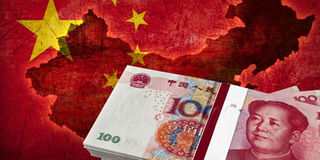China's growth data may mask economic risks- research group

China's GDP growth may be significantly slower than official estimates suggest and its economy more vulnerable to external shocks than widely believed, a global business think tank has warned.
Data due next week is expected to show the world's number-two economy expanded around 6.5 percent last year, its slowest rate in almost three decades as a global slowdown and the US trade war bite.
But even that is well above the 4.1 percent the US-based Conference Board, which provides research to member-businesses and organisations worldwide, says its methodology indicates.
Economists in China and abroad have long suspected data is massaged upward, often noting that full-year gross domestic product hits Beijing's pre-set targets with suspicious regularity.
The governor of northeastern Liaoning admitted in 2017 that the industrial province had falsified data for years.
Even current Premier Li Keqiang said in 2007, when he was Liaoning's top political official, that results were often "man-made" and he used his own calculations to guide provincial policymaking, according to a confidential memo released by WikiLeaks.
The Conference Board, whose research is widely tracked by investors and policymakers, began making its alternative China figures public in 2014.
David Hoffman, its senior vice president for the Asia-Pacific, said Chinese data reporting problems do not factor into the Board's calculations.
Heightened vulnerability
Its numbers differ mainly because it looks at industrial output and service-sector growth using different methodologies intended to reduce distortions in official pricing mechanisms.
Its data indicates growth in China, now a vital component of the world economy, may have been more volatile and vulnerable to outside factors than official readings let on.
For example, the National Bureau of Statistics (NBS) says growth dipped to 7.8 percent in 1998 during the Asian financial crisis, from 9.2 percent in 1997.
But The Conference Board's calculations show 1998 growth may actually have been 2.3 percent, half that of the previous year.
Subsequent shocks may also have been smoothed over, most recently the 2014-2015 oil and commodity price deflation cycle.
The Conference Board estimates 2015 growth fell to 3.8 percent, from 6.3 percent the previous year. Official numbers, however, show a relatively small dip to 6.9 percent, from 7.3 percent.
Economic growth is a sensitive topic for the Communist Party, which has based its ruling legitimacy largely on delivering constant expansion and rising living standards.
Hoffman said if the Board's numbers are correct, "it makes the case for substantive economic reforms (by China) all the more urgent, especially in the face of intensifying external factors such as trade conflict and slowing global demand".
Some believe China's growth may be even lower.
Xiang Songzuo, a finance professor at Beijing's Renmin University and former chief economist of China Agriculture Bank, said in a lecture last month that 2018 growth may have been as low as 1.67 percent, or even contracted.
Video of Xiang's lecture was widely circulated online until government censors moved to block it.
Data crackdown
The NBS did not respond to a request for comment but acknowledges the data problem.
Last week it said it would launch a "first-ever" crackdown on falsification this year and implement a "unified" nationwide system of calculating growth.
It may not like what it finds in 2019.
Last year, the China-US trade battle may actually have boosted Chinese exports temporarily as manufacturers rushed out shipments ahead of the onset of US tariffs.
But that has ended -- December exports fell 4.4 percent year-on-year -- and The Conference Board's senior economist Gao Yuan said external pressures on China's economy "are likely to show up more significantly" over the next 12 months.
That further complicates Beijing's efforts to address its economic slowdown, clean up worrying debt levels, and the larger goal of transitioning away from an economic model based on exports, manufacturing and investment to one more reliant on domestic consumption.
Such priorities require a cushion of solid growth to execute, economists say, but The Conference Board sees China's growth slowing further to an average 3.8 percent for 2019-2023, and 3.4 percent in 2024-2028.
China's economy is "slowly decelerating, similar to the official data, but at a lower level of growth", Gao said.



